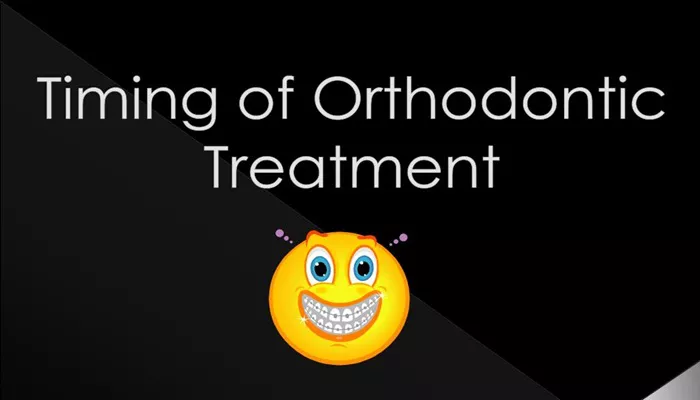Orthodontic treatment plays a crucial role in aligning teeth and correcting bite issues, leading to enhanced dental health and aesthetics. The timing of orthodontic intervention is essential to ensure the most effective outcomes and minimize potential complications. Understanding when to start orthodontic treatment can help patients achieve optimal results and maintain their oral health. This article explores the ideal timing for orthodontic treatment, including factors influencing the decision and the benefits of early and late intervention.
The Importance of Timing
The timing of orthodontic treatment is pivotal for several reasons:
Effectiveness: Early intervention can address problems before they become severe, potentially reducing the need for more complex treatments later.
Growth and Development: Timing treatment according to the patient’s growth stages can help guide the development of the teeth and jaws, leading to better outcomes.
Patient Comfort: Proper timing can minimize discomfort and inconvenience for the patient, making the treatment process more manageable.
SEE ALSO: What Happens If You Don’t Get Orthodontic Treatment?
Early Orthodontic Treatment
Early orthodontic treatment, often referred to as interceptive or phase one treatment, is typically recommended for children between the ages of 7 and 10. The American Association of Orthodontists (AAO) suggests an initial evaluation by age 7 to assess if early intervention is needed.
Benefits of Early Orthodontic Treatment
Guiding Growth and Development: Early treatment can guide the growth of the jaws and teeth, helping to correct issues before they become more complex. This can prevent the need for more extensive treatments later on.
Preventing Severe Problems: By addressing issues such as severe overcrowding or crossbites early, orthodontists can prevent these problems from worsening, which can lead to more complicated treatments in the future.
Improving Self-Esteem: Early intervention can improve a child’s appearance and self-esteem, which can be especially important during the formative years.
Reducing the Need for Extraction: Early treatment can sometimes reduce the need for tooth extractions later by creating enough space for permanent teeth to come in properly.
When Is Early Treatment Necessary?
Early treatment is not always required, but it may be necessary in the following cases:
Severe Crowding: If there is a significant lack of space for permanent teeth to emerge, early intervention can help create the necessary space.
Crossbites: If a child has a crossbite, where the upper teeth do not properly fit over the lower teeth, early treatment can prevent more serious issues.
Overbites or Underbites: Significant bite discrepancies can be addressed early to prevent functional problems and jaw pain.
Habits: Persistent habits such as thumb sucking or prolonged pacifier use can be addressed early to prevent their impact on dental development.
Comprehensive Orthodontic Treatment
Comprehensive orthodontic treatment typically begins during adolescence, around ages 11 to 14, when most of the permanent teeth have erupted. This phase aims to address remaining orthodontic issues that were not fully resolved by early treatment or that developed as the patient grew.
Benefits of Comprehensive Orthodontic Treatment
Addressing Alignment Issues: Comprehensive treatment focuses on aligning the teeth and correcting the bite, ensuring that the patient achieves a well-aligned and functional smile.
Enhancing Aesthetics: As the patient approaches adulthood, achieving an aesthetically pleasing smile can have a positive impact on their self-confidence and overall appearance.
Preventing Future Problems: Properly aligning the teeth and correcting the bite can prevent future dental issues such as wear and tear on the teeth, jaw pain, and difficulty with oral hygiene.
Long-Term Results: Comprehensive treatment typically results in more stable and long-lasting results, as the teeth and jaws are aligned according to their final growth patterns.
Factors Influencing The Ideal Time for Orthodontic Treatment
Several factors influence the ideal timing for orthodontic treatment:
Dental Development: The development of the teeth and jaws plays a significant role in determining the timing of treatment. Orthodontists assess the eruption of permanent teeth and the alignment of the bite to decide when treatment should begin.
Severity of the Problem: The severity of the orthodontic issue can impact the timing of treatment. More severe problems may require earlier intervention, while less severe issues may be addressed with comprehensive treatment during adolescence.
Patient Cooperation: The patient’s ability to comply with treatment requirements, such as wearing appliances or maintaining good oral hygiene, is crucial. Younger children may have more difficulty adhering to treatment guidelines, so the timing of intervention may consider their readiness.
Growth Patterns: The timing of orthodontic treatment often takes into account the patient’s growth patterns. Early treatment may be used to guide growth, while comprehensive treatment aligns with the final stages of growth and development.
Monitoring And Evaluation
Orthodontic treatment requires ongoing monitoring and evaluation to ensure that the timing of treatment is appropriate.
Regular check-ups with the orthodontist help assess the progress of treatment and make any necessary adjustments.
Conclusion
The ideal time for orthodontic treatment depends on various factors, including the patient’s age, dental development, the severity of the orthodontic issue, and growth patterns. Early orthodontic treatment can address issues before they become severe, while comprehensive treatment during adolescence focuses on achieving optimal alignment and aesthetics.

